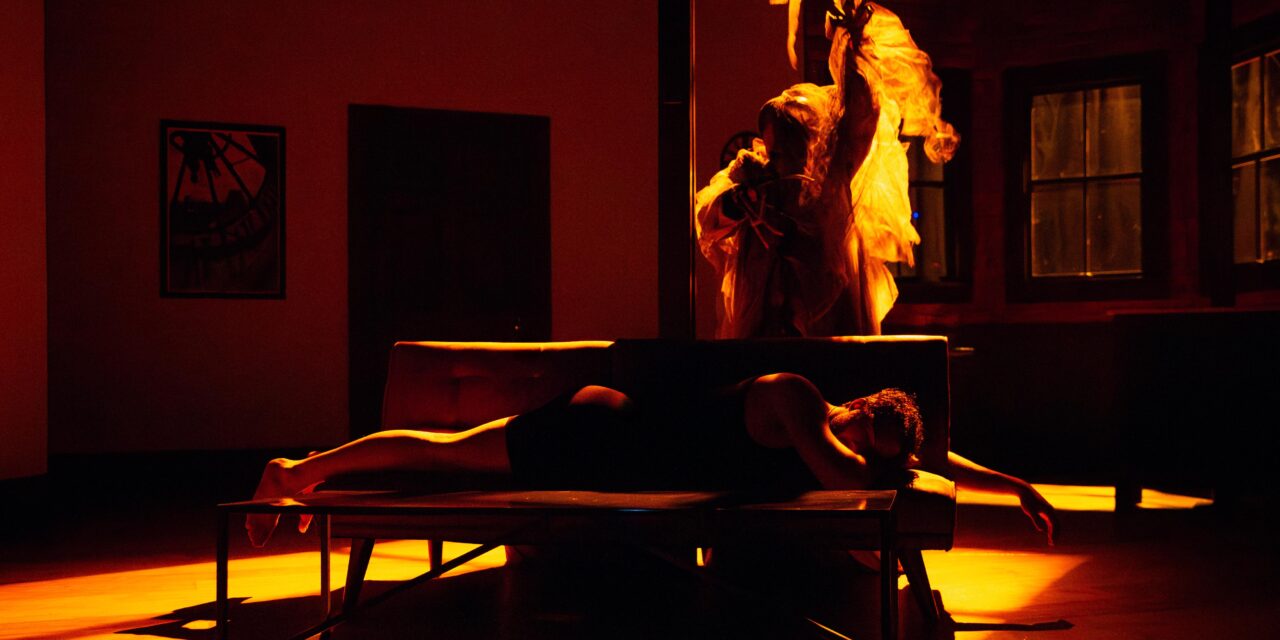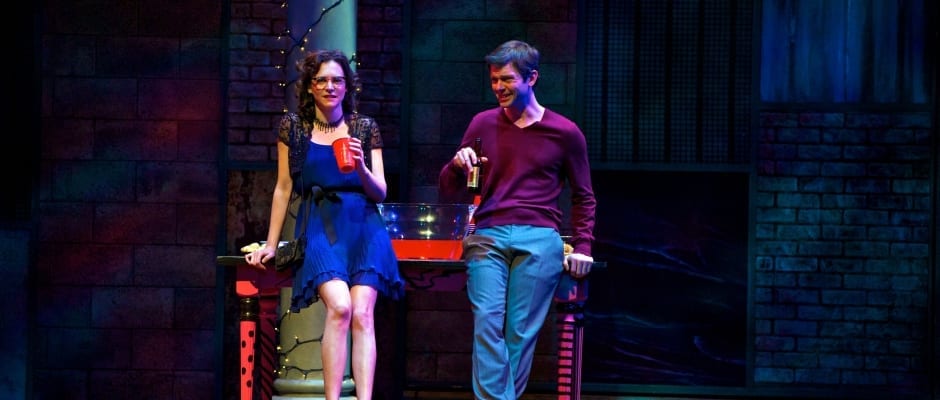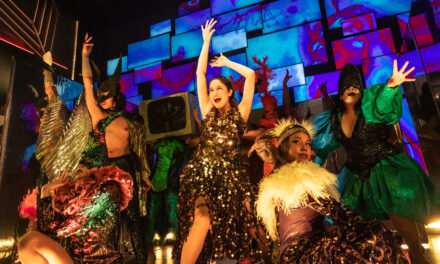
SALT LAKE CITY—Salt Lake Acting Company (SLAC) is currently staging the regional premiere of Chisa Hutchinson’s Whitelisted, running from October 2–27, 2024, under the direction of Latoya Cameron and Tito Livas. This powerful theatrical work masterfully blends suspense with sharp social commentary, challenging audiences to confront privilege, surveillance, and the subtle yet pervasive ways racial dynamics unfold in contemporary society. Set within the intimate confines of a New York City apartment, Whitelisted pulls viewers into a deeply psychological space where everyday anxieties intertwine with the haunting realities of race and power.
Hutchinson’s Whitelisted originally premiered on October 22, 2022, at the Contemporary American Theater Festival (CATF) in Shepherdstown, West Virginia. This is the perfect Halloween show due to its masterful blend of psychological horror and comedy, creating a suspenseful atmosphere that keeps audiences on the edge of their seats. Hutchinson explores themes of isolation and fear, resonating with the Halloween spirit of confronting the unknown as the protagonist grapples with eerie and unexplained phenomena in her apartment.
The cast of Whitelisted delivers captivating and layered performances, each actor bringing nuance to their respective roles. Colette Astle, as the protagonist Rebecca, is riveting. Her portrayal of a woman slowly unraveling under the weight of both supernatural occurrences and the subtler menace of privilege-induced isolation is a tour de force. Astle seamlessly transitions between confidence, fear, and paranoia, pulling the audience along as her character’s world spirals out of control. The impact of this show is contingent on Hutchinson’s portrayal of “white privilege” coupled with the vision of directors Cameron and Livas and Astle delivers.
Dee-Dee Darby-Duffin (Yvette/Officer Black) delivers a performance that is both haunting and deeply emotional. She brings a raw vulnerability to each of her roles, making each moment she’s on stage feel visceral and impactful. From the moment Darby-Duffin steps on the stage, she demands the audience’s attention; her portrayal of Yvette, in particular, cuts deep, offering a character whose pain and frustration over being unseen and unheard resonate powerfully.
Jacob Barnes (Diego) is one of the best parts of this show, providing much-needed comic relief in both the tense and terror-inducing moments. Amidst Rebecca’s dismissive and racist remarks, Barnes as Diego offers a controlled and humanizing presence in contrast to Rebecca. Chisa Hutchinson brilliantly creates a character in Diego with the ability to maintain a light-hearted energy while still invoking reflection on societal privilege, and Barnes strikes a balance between warmth and thoughtfulness, making his character both memorable and likable. A standout moment in the play occurs when Diego, a Latino character, confronts Rebecca about her dismissive comment referring to all Black women as “angry Black chicks.” His reaction is understandably upset, as he challenges her reduction of an entire race to a single stereotype. This interaction highlights the complexities of race and the importance of recognizing and rejecting harmful generalizations. It also represents the type of person Diego is in contrast to Rebecca.
Eliyah Ghaeini (Ryan/Officer White) deftly handles his dual roles, switching between them with notable ease—not an easy thing to do. Ghaeini’s charm as the self-absorbed Ryan contrasts with his no-nonsense portrayal of Officer White, highlighting his range as an actor. Betty Kalunga (Maya), though given less stage time, is equally powerful, delivering a poignant and vital performance as Yvette’s sick daughter that adds to the play’s emotional intensity.
One of the standout elements of this production is Erik Reichert’s striking set design. The minimalist yet chilling apartment setting plays a crucial role in creating the play’s haunting atmosphere. Though deceptively simple, the set cultivates a sense of normalcy that is slowly overtaken by an eerie presence, amplifying the tension throughout. Reichert expertly utilizes space to heighten the feeling of claustrophobia, making the mundane terrifying and underscoring how easily everyday life can turn dark. The design beautifully mirrors Rebecca’s psychological unraveling, with subtle environmental changes deepening the suspense. By the end of the play, it is clear that Rebecca’s apartment is a metaphor for her internal struggle, and her mini apartment (Rebecca designs mini homes and furniture for a living) will foreshadow Rebecca’s demise. I was especially impressed by the use of orange lighting for the night scenes, which perfectly captured the hue of a New York street lamp. Kudos to Jesse Portillo for his exceptional lighting design, which added another layer of realism and atmosphere to the production. Portillo’s lighting design is masterful, with dim lighting, flickering bulbs, and sharp spotlights working together to amplify the mood swings between calm and terror.
Joe Killian’s sound design also played a significant role in heightening the tension. The use of low, pulsating sounds and eerie whispers that seemed to come from all directions created a haunting auditory experience. Such moments drew the audience into the discomfort and paranoia of the characters, especially during key moments of psychological dread. There are a few audible exhalations at key moments after the phrase “she can’t breathe,” referring to Kalunga’s Maya; these were powerful. Dennis Hassan’s costume design brings another layer of realism and unease to the production. The choice of fabrics, textures, and colors not only placed the characters within the world of the play but also helped reflect their inner struggles, with small details subtly shifting alongside the play’s tone.
The play’s build-up is intense, but the climax, though effective, is quick. A bit more breathing room in the final confrontation between Rebecca and the supernatural forces—both literal and metaphorical—could provide a stronger, more resonant conclusion. The antagonist, Rebecca, is portrayed as a complex embodiment of white privilege, yet her character arc feels somewhat incomplete. A deeper exploration of her internal struggles or how she became the way she is could pronounce moments of self-awareness.
In conclusion, Whitelisted is a profound piece of theatre that is both timely and relevant. Each cast member brings authenticity and emotional weight to their roles, making the story both engaging and impactful. Astle and Darby-Duffin, in particular, deliver standout performances that linger long after the final curtain. The combination of Reichert’s set design, Killian’s soundscapes, and Portillo’s lighting elevated the psychological horror elements, immersing the audience in an unsettling world. The attention to detail in these areas made for a more immersive and spine-tingling experience. Hutchinson’s script tackles relevant social issues such as race, privilege, and surveillance culture. The way these themes are woven into the narrative, without feeling forced or preachy, makes the play both engaging and thought-provoking.
Whitelisted plays at Salt Lake Acting Company Wednesday through Saturday Evenings at 7:30pm with Sunday matinees at 1pm and 6pm. There are a few other performances as listed on the website. The theatre is at 168 W 500 N Salt Lake City, Utah, 84103. Tickets are $45. For more information see https://www.saltlakeactingcompany.org/

These reviews are made possible by a grant from the Salt Lake County Zoo, Arts, and Parks program.





